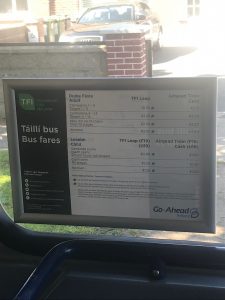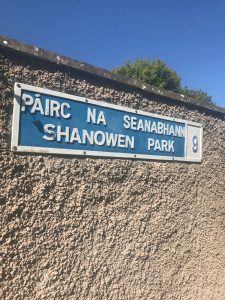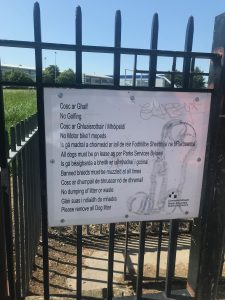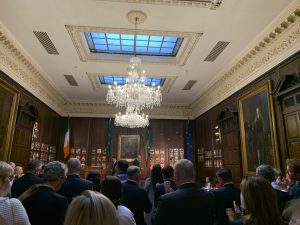When I stepped off the airplane in Dublin and encountered an informational sign in Irish, I couldn’t help but laugh. Maybe it was due to the fact that I had spent the last seven hours wide awake on a plane (despite an extra-large dose of melatonin), but I was completely dumbfounded to find an informational sign written in the Irish language. Prior to coming to Ireland, I knew very little of the Irish language, believing it to be something spoken in rarity amongst old family members or at events steeped in history and tradition. I was shocked to find as I continued through the airport, then out into streets and on to public transportation, that every street and transportation sign included both English and Irish, with Irish securing the line above the English translation.

Despite the prevalent use of Irish across government issued signage, I did not find the language being used in other types of signage, such as business or commercial signs. This makes the linguistic landscape of Dublin very unique, as the language is only used in specific, highly publicized areas. The “linguistic outward appearance” (Leeman and Modan, 333) of Dublin might seem to be multilingual at first because of the usage of Irish on street signs and transportation lines. If you examine the ‘areas of activity’ (Leeman and Modan, 335) that Irish is found in, you would discover that Irish exists in public functional areas, most notably transportation. Electronic bus signs flicker between their English and Irish translations, and bus stops and announcements are played in both languages. However, English is the primary language of speaking and commercial signage, pointing to a more monolingual community. Instead of English and Irish being interwoven in signage, advertisements, and public and private speech, Irish is regulated to existing in government-issued signage and amongst private citizens.


The use of Irish in Dublin can be contrasted quite starkly with the example of D.C.’s Chinatown that was described at length in the piece by Leeman and Modan. Whereas the use of Chinese is a symbol and commodification of ethnicity (Leeman and Modan, 354), the use of Irish is relegated only to government-issued signage. It isn’t found on business or commercial signs, trying to lure in tourists with a promise of Irish authenticity. It also isn’t spoken casually between Irish citizens. On the rare occasion I encountered the language apart from signs or bus announcements, it has been in very private, intimate spaces. Two notable instances include a welcoming reception for the Lord Mayor, where speeches were done entirely in Irish, and a recital for Irish schoolchildren, where the emcee volleyed her speech back and forth from Irish to English.

After a month of living in Dublin, from reading countless street signs and hearing my bus stops called out in Irish–but still being able to communicate entirely in English–I have found that Irish is used across the linguistic landscape of Dublin in a very symbolic sense. Irish is not the primary language people use to conduct business or give directions, rather it is used by the government in specific settings to keep some semblance of the Irish language and culture not only alive, but somewhat relevant and useful. Though I can’t speak to how successful this aim is, the Irish language still has a notable presence in Dublin’s linguistic landscape.
Works Cited
Leeman, Jennifer, and Gabriella Modan. “Commodified Language in Chinatown: A Contextualized Approach to Linguistic landscape1.” Journal of Sociolinguistics, vol. 13, no. 3, 2009, pp. 332–362.
I thought your experience with Irish Gaelic was very similar to mine! It was interesting to see how you interacted with the language in unique situations. The revival of the language seems to be carried out with a very conscious effort, I hope it ends up being successful.